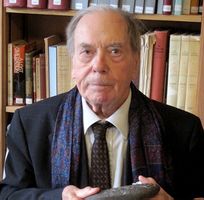Snellgrove, D.: Difference between revisions
No edit summary |
No edit summary |
||
| Line 2: | Line 2: | ||
|pagename=Snellgrove, D. | |pagename=Snellgrove, D. | ||
|PersonType=Authors of English Works; Professors; Translators | |PersonType=Authors of English Works; Professors; Translators | ||
|images=File:Snellgrove David Ancient India and Iran Trust.jpg | |||
|HasDrlPage=Yes | |HasDrlPage=Yes | ||
|HasLibPage=Yes | |HasLibPage=Yes | ||
Revision as of 17:04, 14 February 2020
| PersonType | Category:Authors of English Works Category:Professors Category:Translators |
|---|---|
| FirstName / namefirst | David |
| LastName / namelast | Snellgrove |
| namemiddle | Llewellyn |
| MainNamePhon | David Snellgrove |
| bio | David Llewellyn Snellgrove (29 June 1920 – 25 March 2016) was a British Tibetologist noted for his pioneering work on Buddhism in Tibet as well as his many travelogues. Snellgrove was born in Portsmouth, Hampshire, and educated at Christ's Hospital near Horsham in West Sussex. He went on to study German and French at Southampton University. In 1941 he was called up to do his military service as a member of the Royal Engineers. He attended the Officers Cadet Training Unit in the Scottish seaside town of Dunbar, and was commissioned as an infantry officer. Thereafter he attended various intelligence courses and further training at the War Office in London, from where he requested a posting to India.
Snellgrove arrived in Bombay in June 1943, and travelled cross-country to Calcutta. He was stationed at Barrackpore, some way up the Hooghly River. A few months after beginning his posting he contracted malaria and was sent to the military hospital at Lebong, just north of Darjeeling. It was while he was at Lebong that he began his future life's calling by purchasing some books about Tibet by Charles Bell as well as a Tibetan Grammar and Reader. Snellgrove returned to Darjeeling, from where he sometimes went on leave to Kalimpong. On one of these visits he took a young Tibetan into his personal employ in order to have someone with whom to practice speaking Tibetan. He also travelled in the small Himalayan state of Sikkim, and on one such visit he met Sir Basil Gould, who was then the British Representative for Tibet.[2] Inspired to work in Tibet, in 1946 after he left the Army he sat the entrance exams for the Indian Civil Service. This was the first time the exams had been held since the start of the war, and the last time they were ever held. Although he passed the exams, he was not able to take up an appointment in India. Having already begun to study Tibetan, he resolved to find a university where he could further his studies. However, as no university offered courses in Tibetan at that time he was convinced by Sir Harold Bailey that a sound knowledge of Sanskrit and Pali would be beneficial, so he gained entry to Queens' College, Cambridge in October 1946. While at Cambridge, he converted to Roman Catholicism, in part through the influence of his friend Bede Griffiths. In 1950, after having completed his studies at Cambridge, he was invited to teach a course in elementary Tibetan at the School of Oriental and African Studies University of London.[3] He was Professor of Tibetan at SOAS until his retirement in 1982. Snellgrove's research subsequent to his retirement was focused increasingly upon the art history of South East Asia. He died on 25 March 2016 in Pinerolo, Italy. (Source Accessed Feb 14, 2020) |
| YearBirth | 1920/06/29 |
| YearDeath | 2016/03/25 |
| BornIn | Portsmouth, Hampshire, England |
| affiliation | Professor of Tibetan at the School of Oriental and African Studies (SOAS) |
| religiousaffiliation | Roman Catholicism |
| phduniversity | University of Cambridge, England |
| IsInGyatsa | No |
| Other wikis |
If the page does not yet exist on the remote wiki, you can paste the tag |
Full Name
David Snellgrove
Affiliation
Reader in Tibetan, School of Oriental Studies
Other Information
Interview (video) with David Snellgrove
WorldCat Search: Author David Snellgrove

